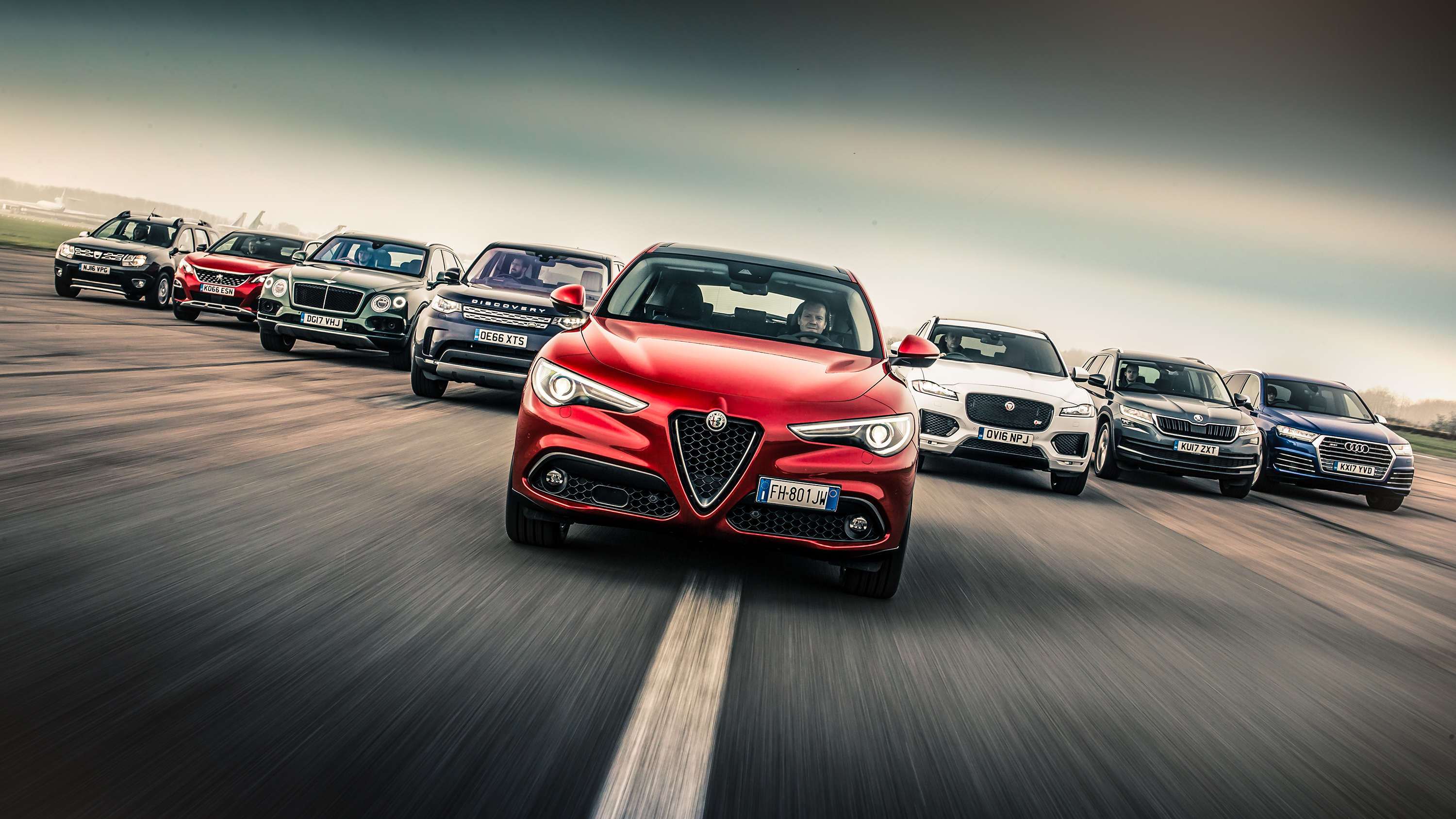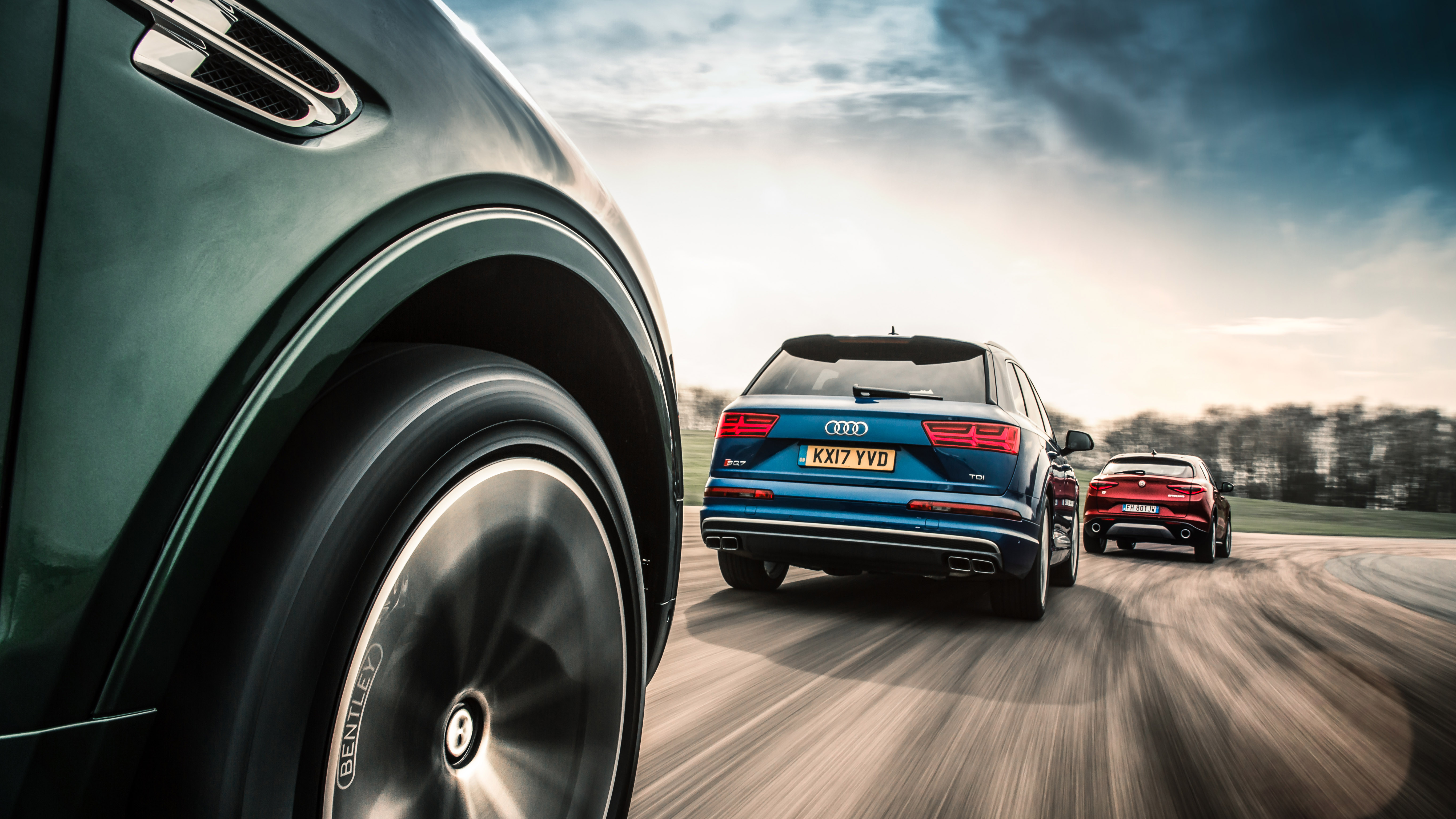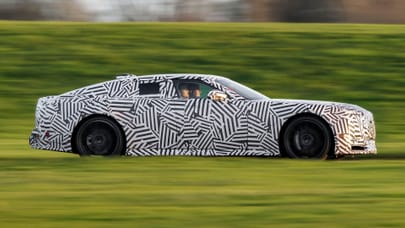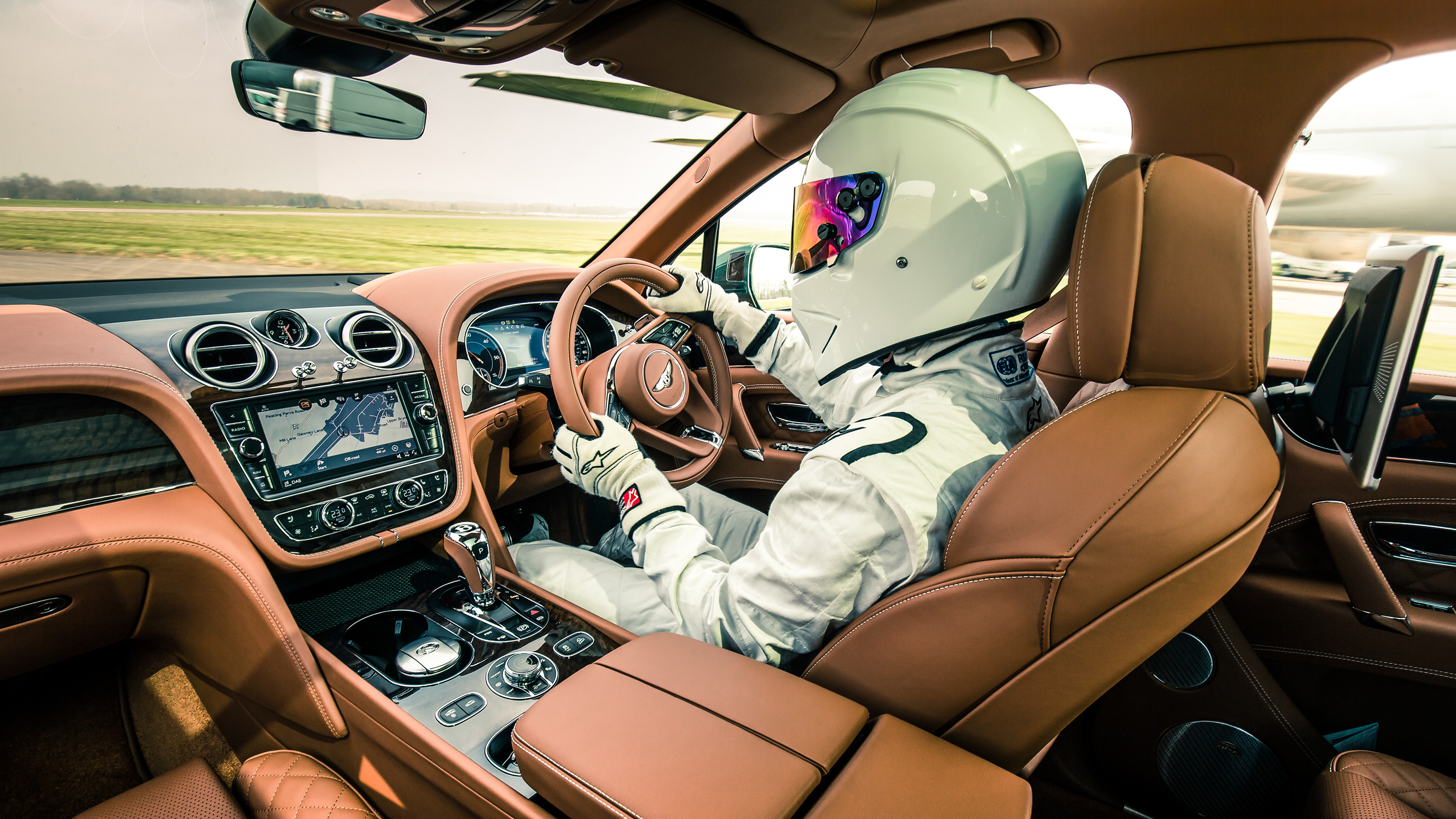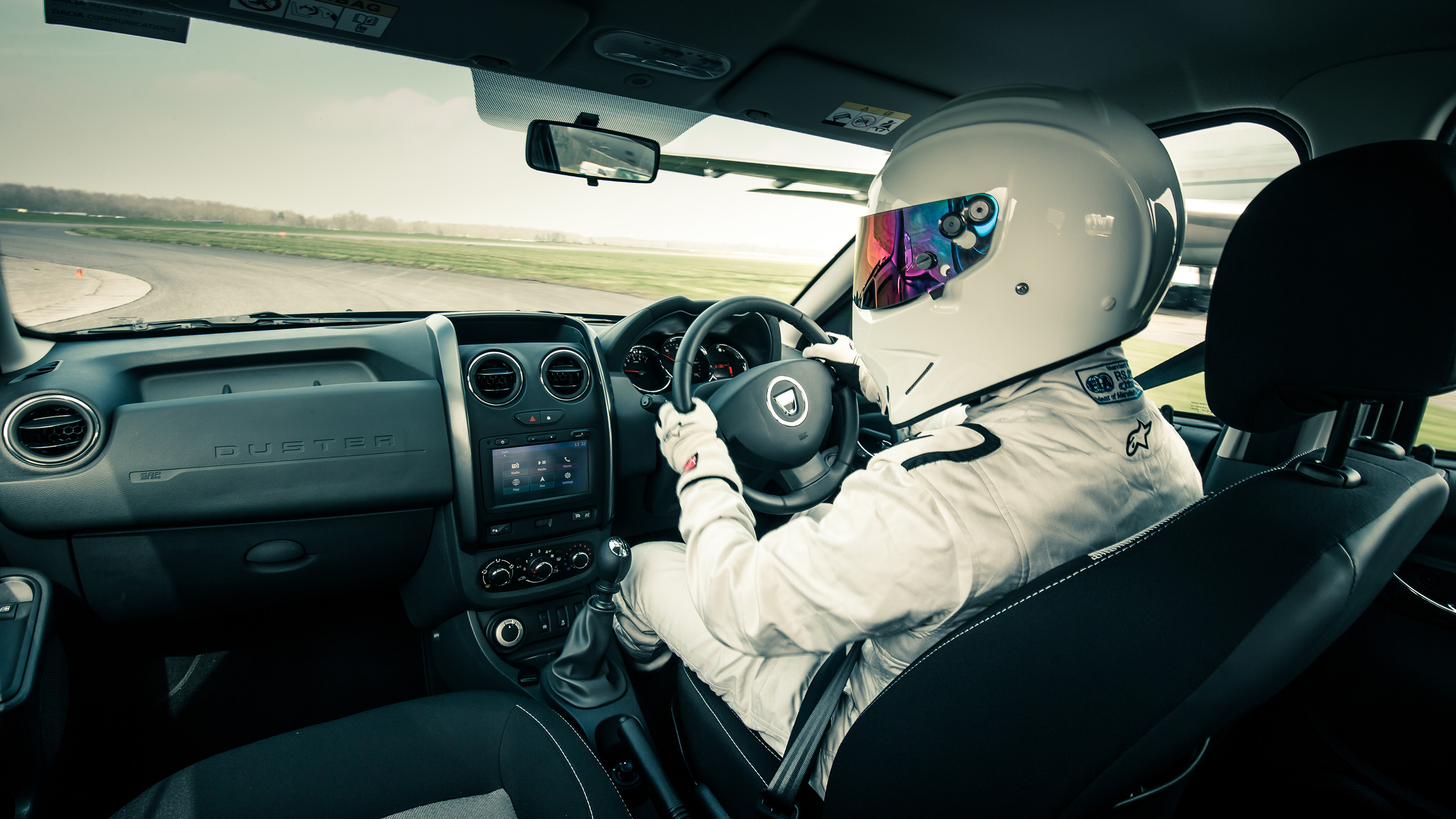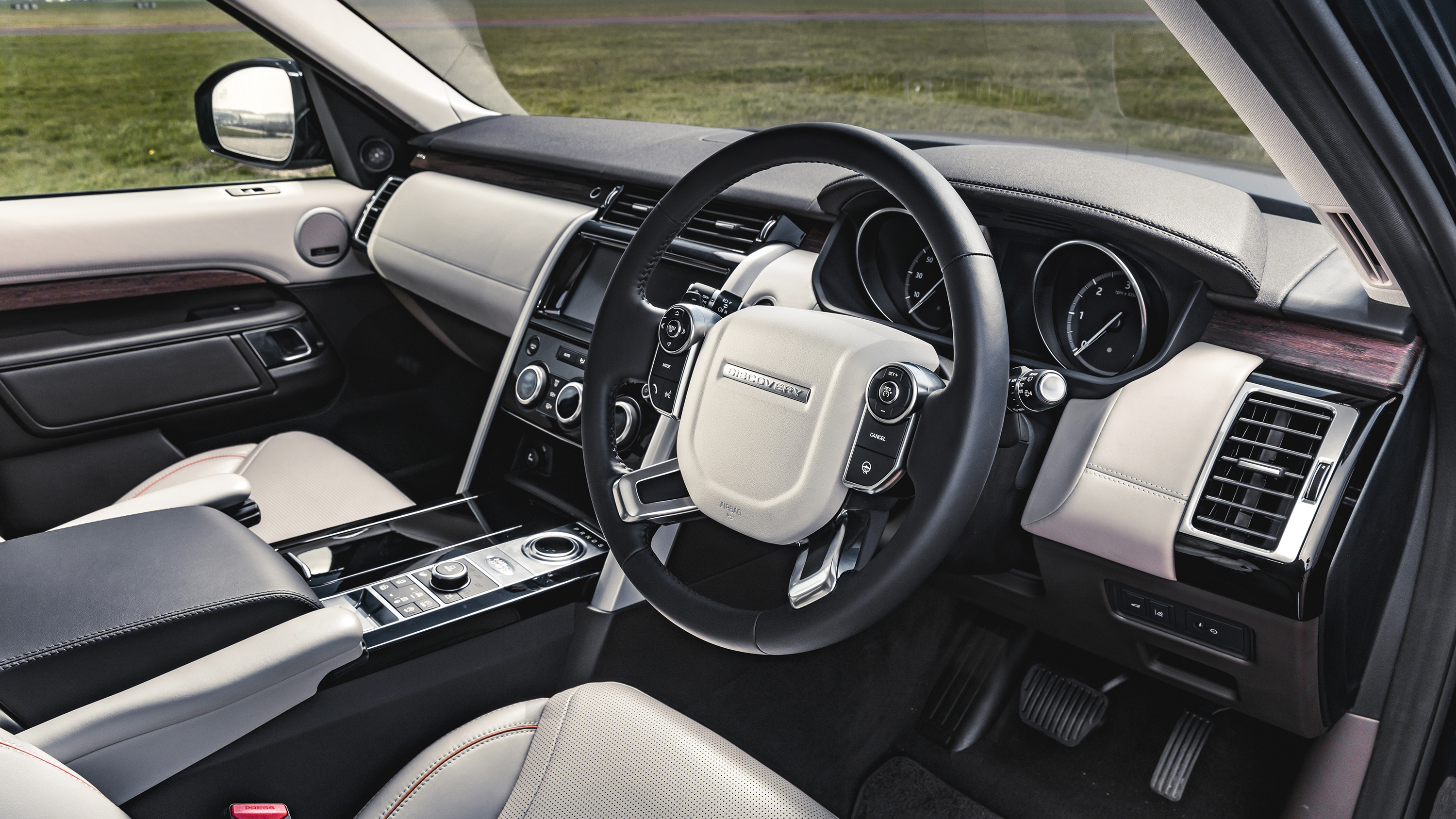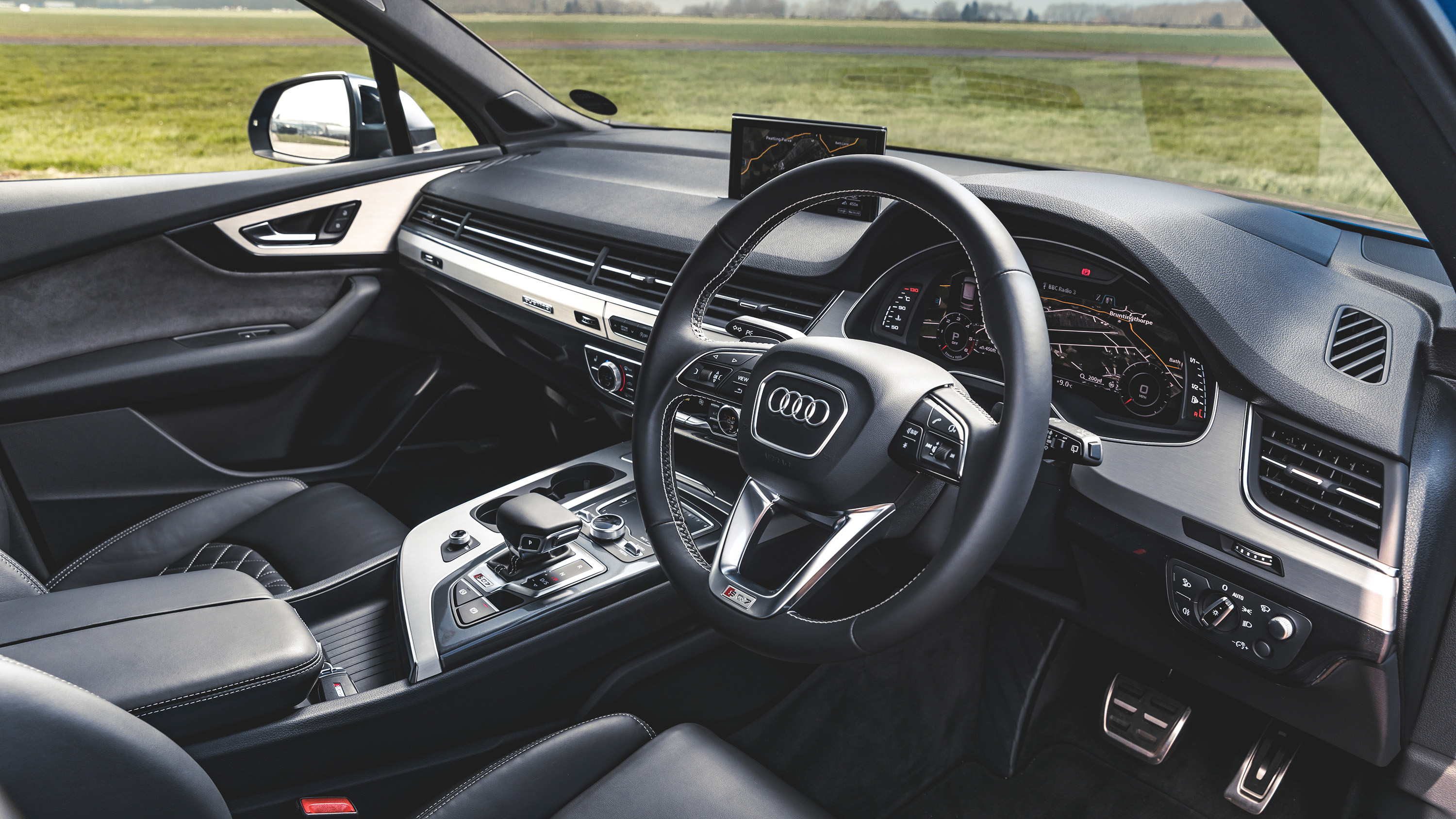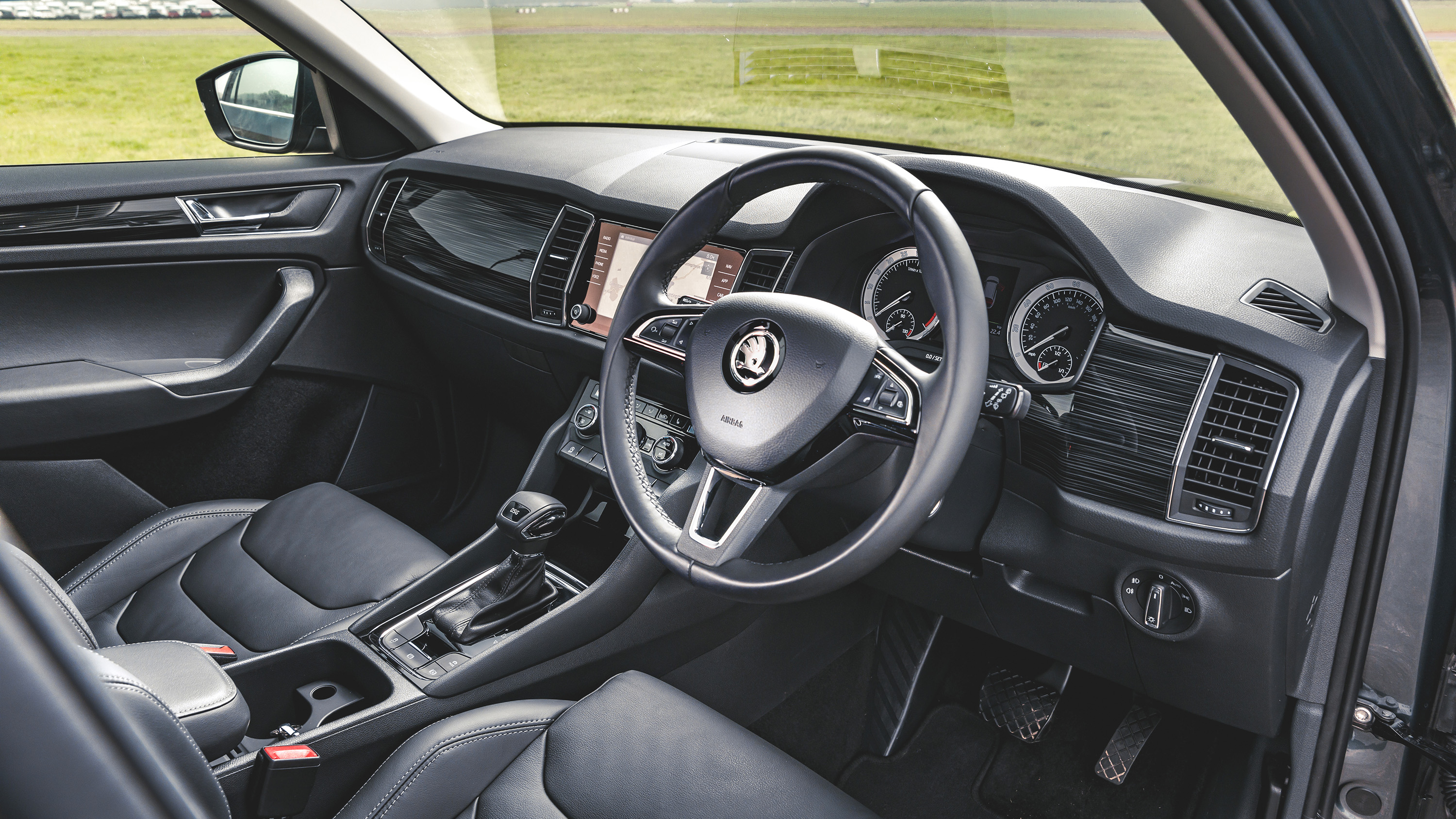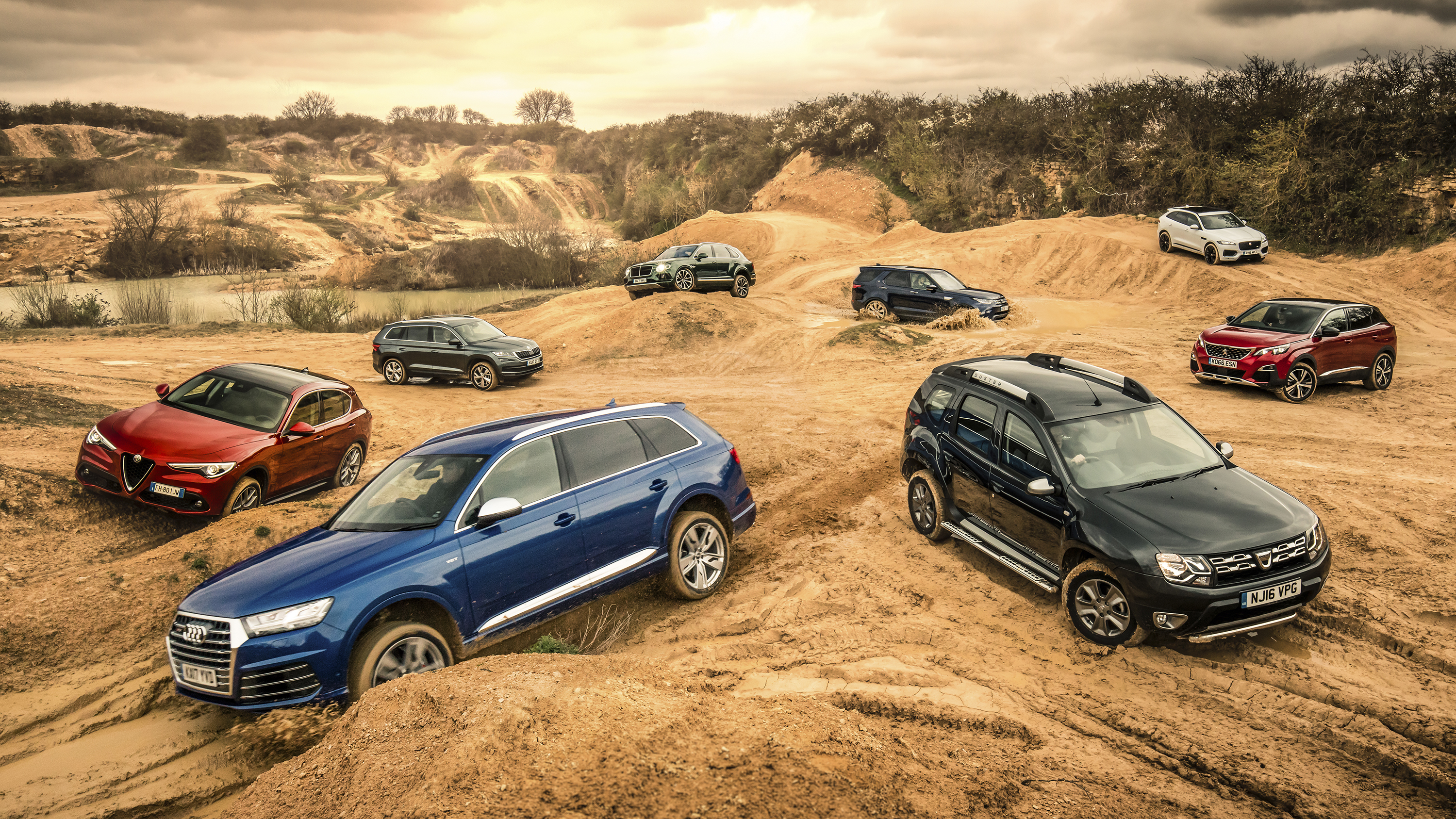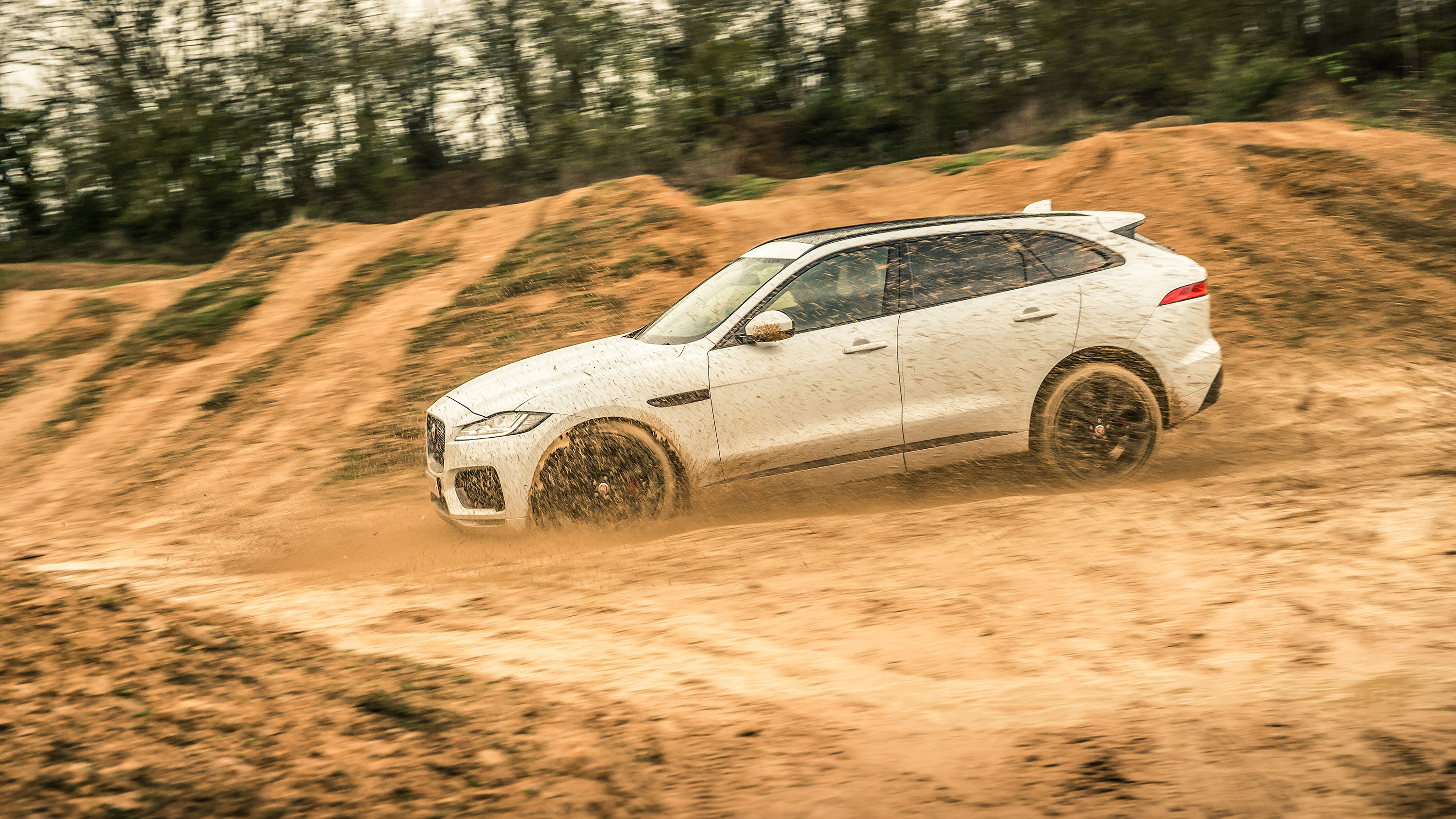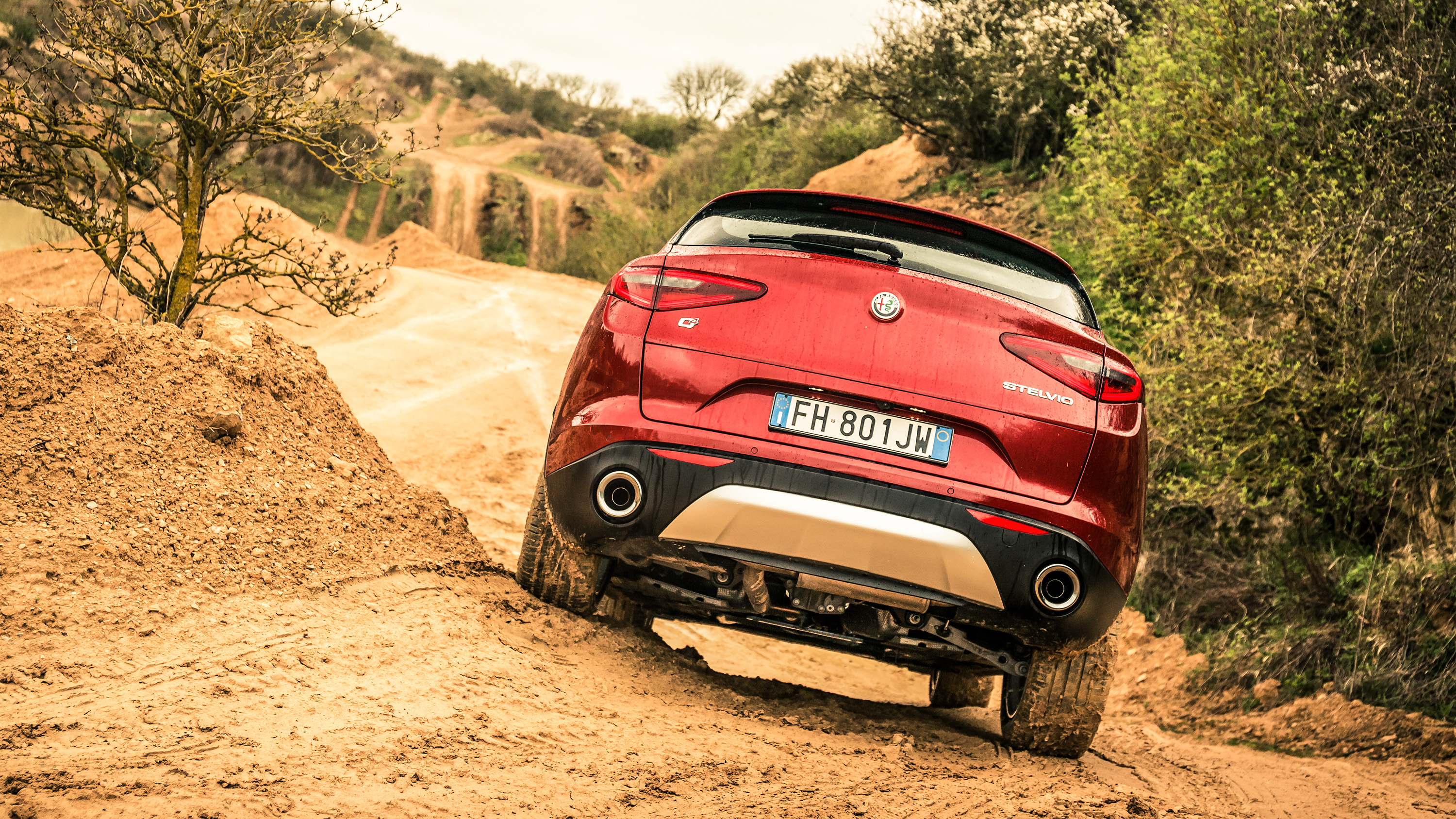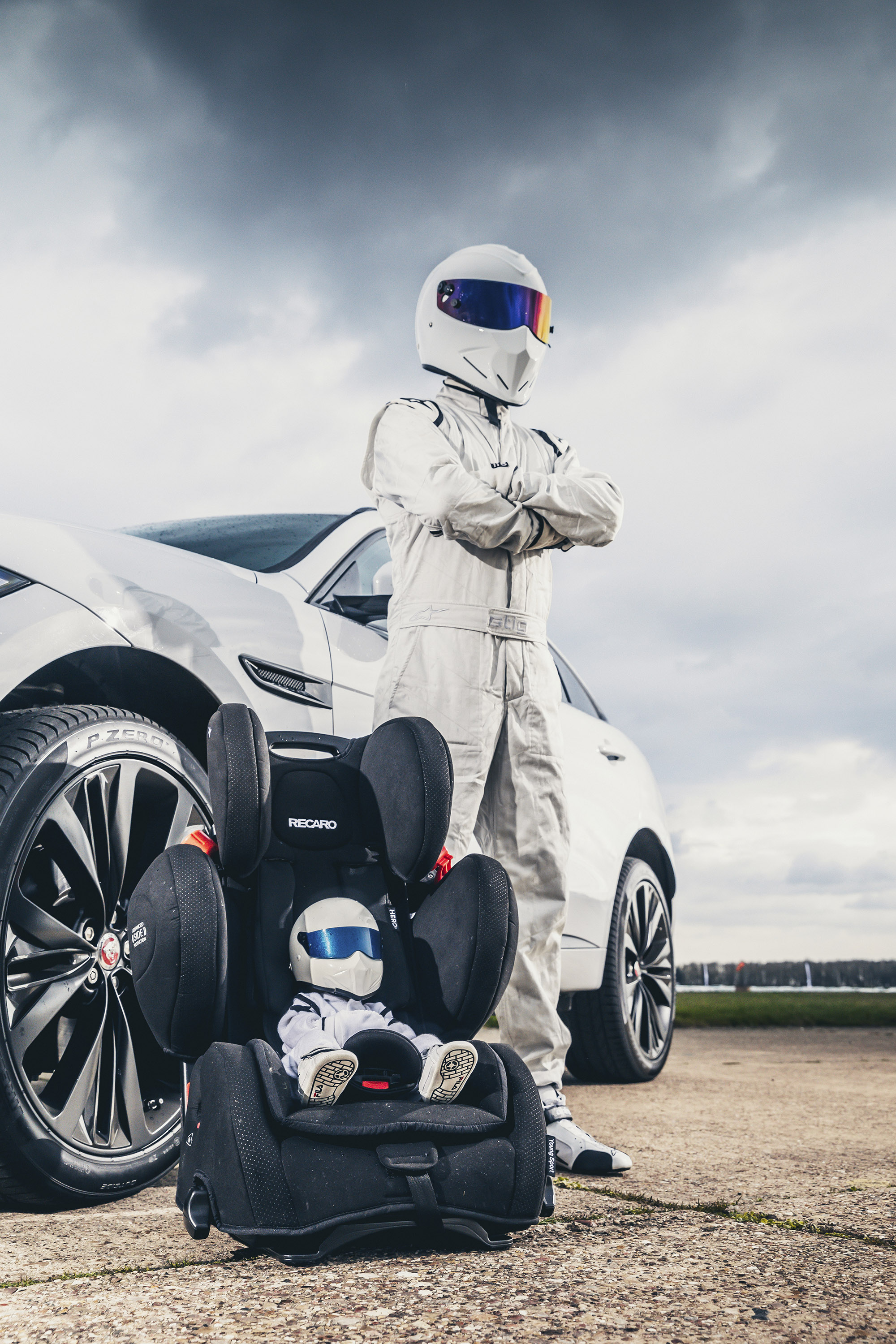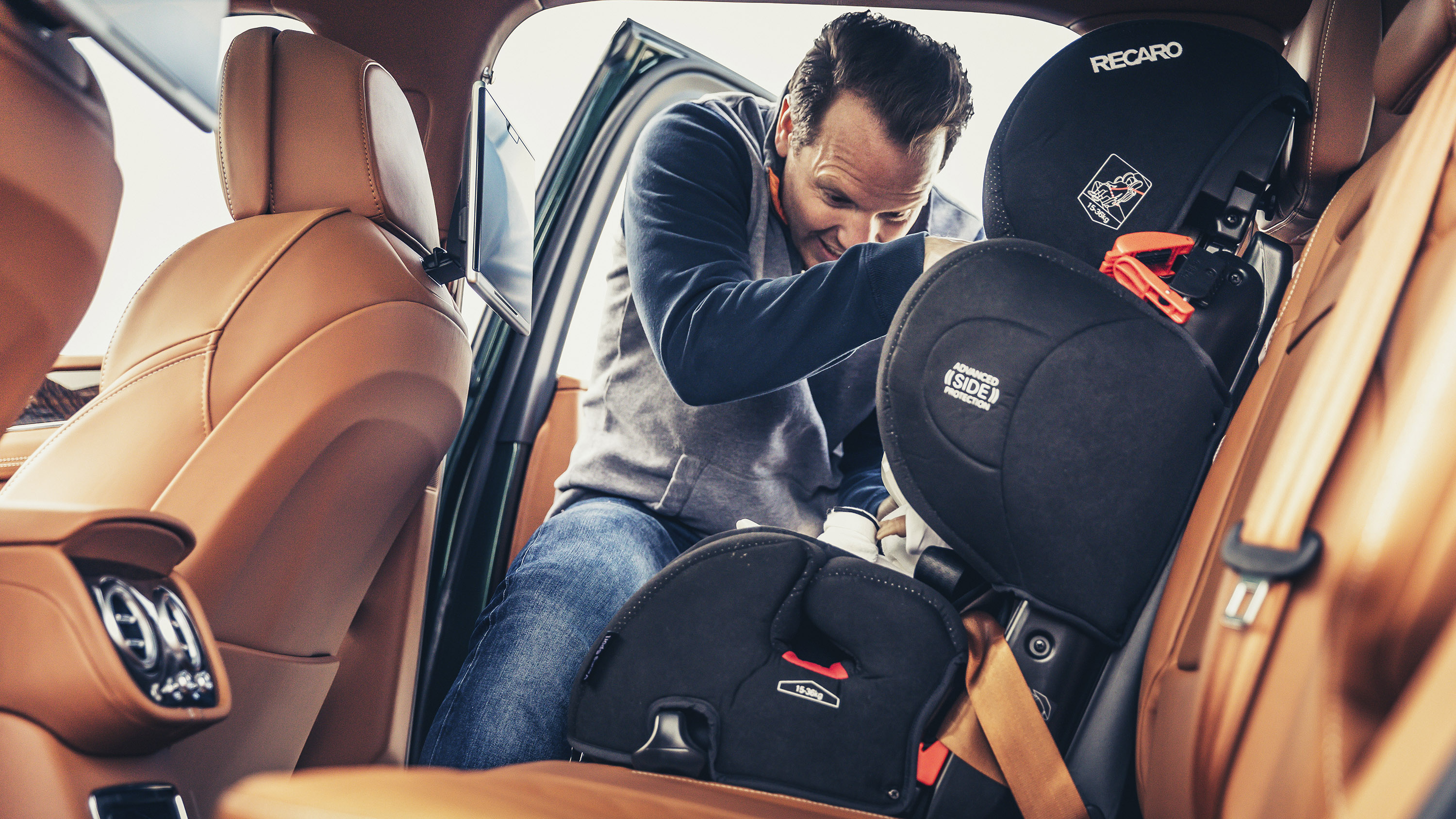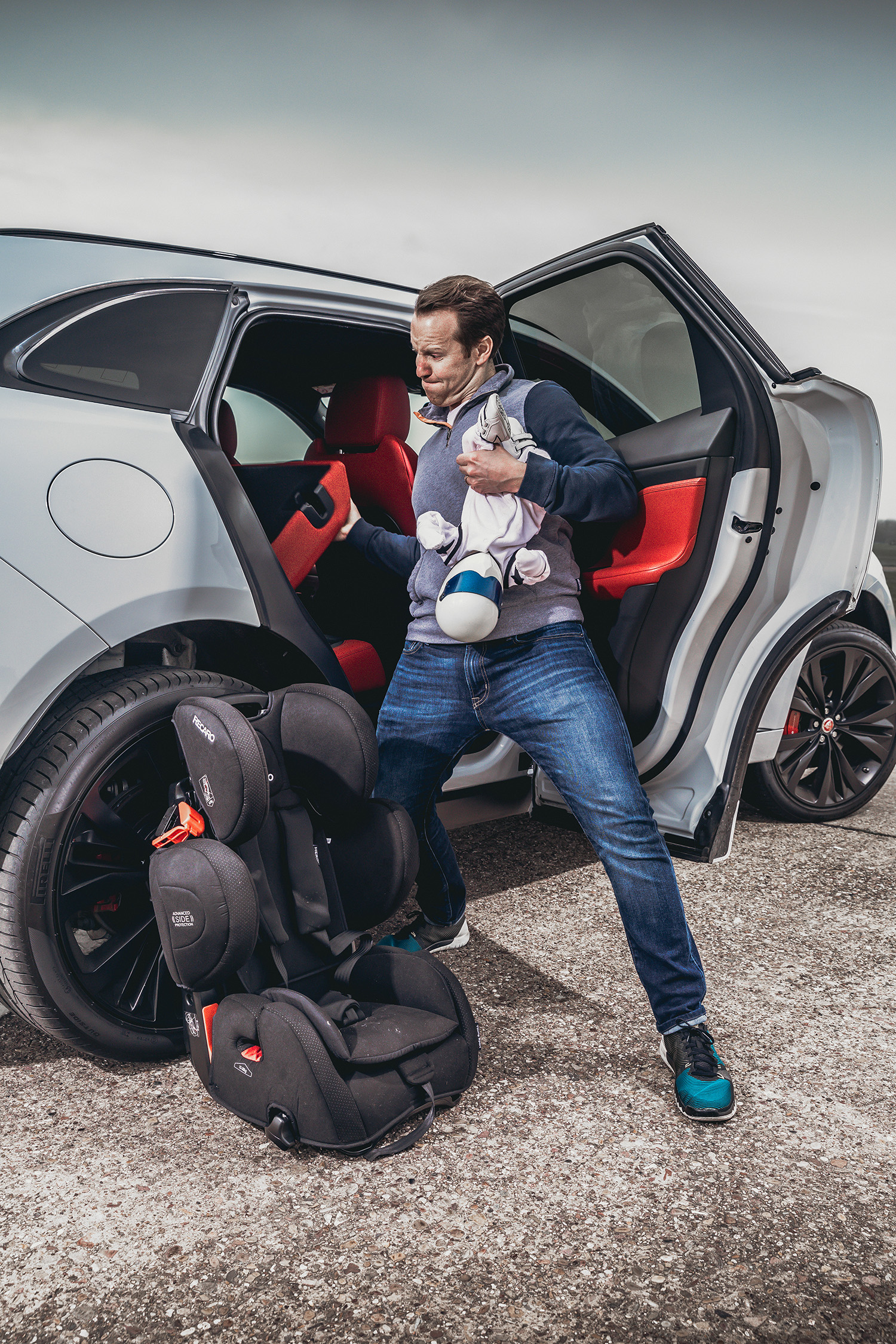
TG's big test: which is the best SUV in the world?
Many SUVs, a track, a runway, a quarry, a shopping centre and a dog. Let the testing begin
Where does a crossover end and an SUV or an off-roader begin? Damned if we know. What we do know is that “SUV” has become the adopted label for a rash of high-riding, ruggedised cars that span mildly jacked-up superminis to seven-seaters capable of fording the Amazon. This presents a problem. So, to find the very best of this diverse bunch, we need stern rules and a multifaceted test that levels the playing field.
There could be only one car from any one maker, and each of our eight contenders had to be our current favourite from a distinct category. That gives us, in no particular order: Land Rover Discovery (muddy), Alfa Romeo Stelvio (dynamic), Audi SQ7 (fast), Bentley Bentayga (luxury), Skoda Kodiaq (family), Jaguar F-Pace (stylish), Dacia Duster (bargain) and Peugeot 3008 (sensible).
The test itself has been carefully crafted to make it possible for a Dacia to compete with a Bentley, and a Peugeot to look an Audi square in the eye. For example, what excels in our off-road test will surely stumble in the drag race, and whatever is the most practical can’t also be the most desirable, can it? Points will be awarded for each test, and the winner has the highest score when we’re done and dusted. Simple.
Test One: Handling
We at TopGear are not imbeciles. Well, not all the time. We realise that the average SUV owner is more likely to enjoy cheese-grating their own fingers than they are to take their sports utility vehicle to a racetrack and give it a good thrashing. Even if they did, they wouldn’t be able to drive it up to and beyond the limit like our friend here, The Stig. But there is a purpose to setting banzai lap times, other than marvelling at how quickly Stig can flambé the brakes on a 2.2-tonne Discovery.
Speed around a track points towards grip (something you’ll appreciate on a wet Tuesday when you’re late to pick the kids up), predictable steering, a punchy engine in tune with its gearbox and brakes you can rely on when some dozy twit more interested in WhatsApp than the road pulls out in front of you. Oh, and beasting cars that weren’t necessarily designed for such a thing is an inordinate amount of fun.
Let’s start with the Dacia Duster, which comes out fighting with the most hi-po engine at its disposal and four-wheel drive. Unfortunately, this is a 1.2-litre turbo producing just 123bhp, but it ups the sporting ante with a six-speed manual. Porsche 911R, eat your heart out. Turns out there’s not a bad chassis under there, just not enough power for it to shine. Stig wrings the Duster dry, but still posts the slowest time of the day.
Would you be surprised if I told you that the Skoda Kodiaq is a dynamic revelation? Good, because it isn’t, it’s as sensible as its sensible-pants styling suggests. Issues include a DSG gearbox that, without paddles behind the wheel, is irritatingly slow to react to prods of the gearlever in manual mode, a chassis that understeers like a cruise ship and a distinct lack of lift-off oversteer. These are words I never thought I’d be required to type.
Where the Duster is merely underpowered, and the Kodiaq is unable to keep its mass in check, the front-wheel-drive Peugeot 3008 is just a big, fat killjoy. The 129bhp three-cylinder turbo engine is actually rather perky, but its best efforts to bring some sparkle to proceedings are crushed by the over-intrusive safety systems that shut you down just as things start to get interesting. A quicker lap time than the Duster and Kodiaq, but a moral victory for the Dacia at the Haas/Sauber end of the grid.
If there’s one car that isn’t remotely interested in such childish pursuits, it’s the Discovery. The equivalent of a porky St Bernard digging its paws in to avoid being dragged off to doggy WeightWatchers, it does everything to avoid its Stig-based workout – including setting fire to its own brakes after a single lap. To be fair, it’s a whale out of water, listing alarmingly in quick corners, understeering heroically at any opportunity and refusing to hang onto your chosen gear at high revs, even in Manual and Sport mode. Sorry, Disco, you’ll have your moment in a few moments time.
And then the Stelvio trundles up to the line and proves that it is possible for an SUV to have a sense of humour. The engine, a 207bhp 2.2-litre 4cyl turbodiesel, isn’t exactly Italian exotica, but it’s enough to reveal the best chassis here, and earns it a bonus point. The brakes are strong, and while the steering doesn’t chatter with feedback, it’s Ferrari-quick and the front end is pointy enough to keep up. In fact, the front tyres dig in so hard it cocks a rear tyre in the tighter stuff and lets the rear end rotate around you when you lift off. You can’t turn the traction off fully, which is a drag, but the fact that it didn’t spoil things is a compliment of the highest order.
"The Bentayga diesel is about as subtle as Boris Johnson"
Top Gear
Newsletter
Thank you for subscribing to our newsletter. Look out for your regular round-up of news, reviews and offers in your inbox.
Get all the latest news, reviews and exclusives, direct to your inbox.
The F-Pace was quicker thanks to its two-cylinder and 89bhp advantage, but didn’t feel as at home on the track as the Alfa. There are flickers of finesse: a satisfying RWD feel past the apex, and you can tighten your line with a well-timed lift, but its brakes were toast after two laps.
Speaking of finesse, the Bentayga diesel is about as subtle as Boris Johnson, but bullies its way around the track to devastating effect. Front and centre is the engine – a 429bhp, 4.0-litre V8 turbodiesel – but even that sort of brute force can’t disguise that it, too, wasn’t built for this sort of undignified punishment.
Whereas the Audi SQ7 – a car with the same triple-charged diesel engine as the Bentayga (with an electrically driven compressor that builds boost before the main turbos fill their lungs) – soaks it up and begs for more. In places where the Bentayga understeers, the Audi stays locked to the road and feels faster everywhere – a 176kg weight advantage tends to do that. The steering, brakes, throttle, everything is on espresso-fuelled alert, and the way the 48v active roll control keeps such a lump so flat in the corners is beyond comprehension. It’s the only car here that can build and carry the sort of speeds that make your eyes widen and your palms moisten. A speed machine with space for seven – first blood to the SQ7.
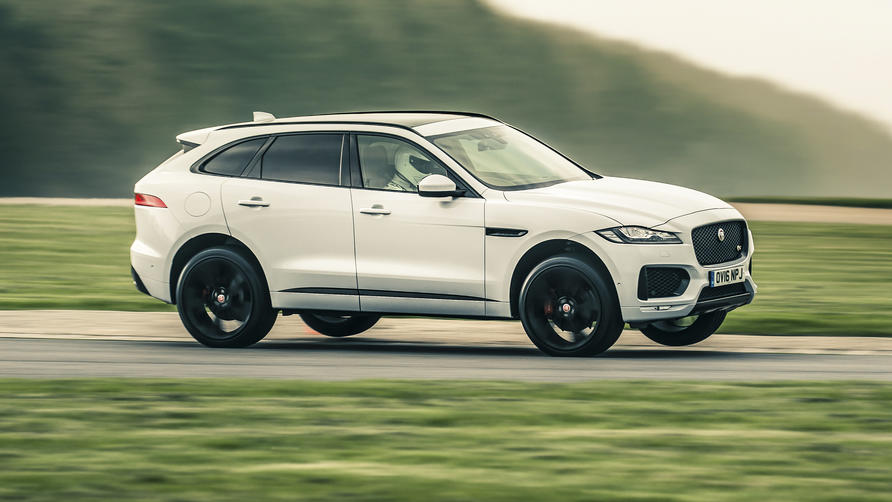
Audi SQ7: 10
Bentley Bentayga: 9
Jaguar F-Pace: 8
Alfa Romeo Stelvio: 7 + 1
Land Rover Discovery: 6
Peugeot 3008: 5
Skoda Kodiaq: 4
Dacia Duster: 3
Test Two: Speed
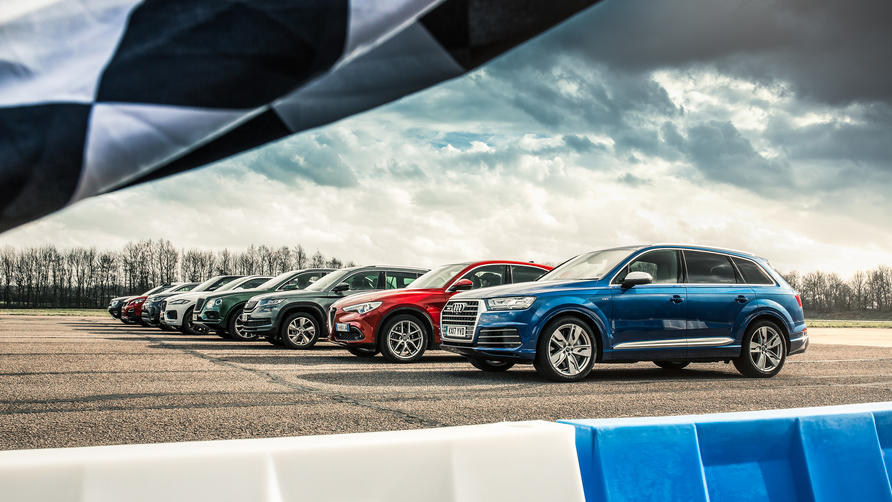
Yet more inappropriate behaviour, yet more important lessons to be learned. Don’t forget, people – speed isn’t just the preserve of racing drivers or testosterone-filled youths, it can be a useful tool for building and maintaining an appropriate velocity when joining a motorway from a slip road. Or making smooth progress up a steep incline. Or… who am I kidding, if you had the chance to drag race eight SUVs, you just would, wouldn’t you?
At the head of the field, it’s little surprise to see the Audi and Bentley, in that order, streaking away with it. In this test, horsepower is king, but what Bentley was thinking, claiming a quicker 0-62mph than the lighter Audi, we’re not sure.
At the embarrassing end of the field, the Duster, expertly driven by yours truly, and the 3008 are left to chew on the gravel flicked up by everyone else’s tyres. In defence of the 3008 and Duster, they are the only two manuals in the line-up and therefore that much harder to launch. Not sure even The Stig could have improved their positions, though.
Scrapping it out for third place are the F-Pace and Stelvio, a battle the Jag rightfully wins, but only by half a second, a result for Alfa to be proud of. Same goes for the Kodiaq that out-drags the 3008, despite being slower than the Peugeot around the track. This confirms what we all suspected: the Kodiaq is truly woeful when asked to corner at speed.
But the biggest surprise of the day comes from the recalcitrant Discovery. Clearly still sulking about being forced to spend the day on a racetrack it’s slowest off the line, even to the Duster, huffs and puffs its way through the first 100 metres, then, once sufficient momentum has been gathered, puts in a burst of speed that leaves the Kodiaq, 3008 and Duster trailing in its not insignificant wake. She’s a big girl.
Just think, in a couple of years from now a remake of this all-SUV dash could include a V8-engined Lamborghini Urus, several face-bending Porsches, a Rolls-Royce, and F-Pace SVR and a 500bhp-plus Alfa. There should be an all-new Dacia Duster by then too. Bagsy the Duster.
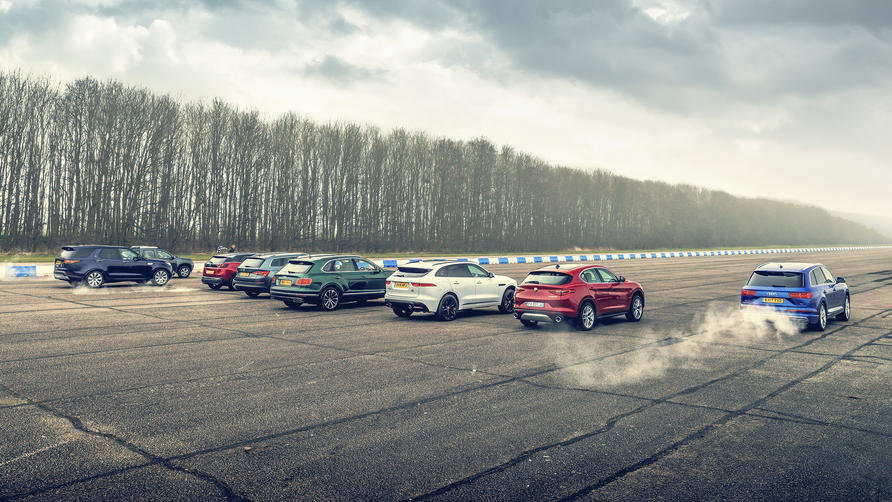
Audi SQ7: 10
Bentley Bentayga: 9
Jaguar F-Pace: 8
Alfa Romeo Stelvio: 7
Land Rover Discovery: 6
Skoda Kodiaq: 5
Peugeot 3008: 4
Dacia Duster: 3
Test Three: Interiors
For sheer interior shock and awe, it’s the Peugeot, actually. The 3008 has a brilliantly brave cockpit, German in its material choice but brandishing enough French idiosyncrasy to feel more interesting than anything from across the border. If you’re going to have virtual dials, why not have about 11 different styles? If you’re reinventing the driving position as we know it (and no, it won’t suit the taller drivers among you, sorry), why not make a flat-top/bottom steering wheel that’s part LaFerrari, part Super Star Destroyer?
The Peugeot’s cabin makes the brutally ergonomic, play-it-straight Kodiaq feel a little undercooked (and tinny to the touch), and embarrasses the F-Pace for imagination and sheer crispness of design. The Jag feels 10 years behind what the 3008 throws in your face – it simply borrows an XE cabin. To be fair, the Stelvio is indistinguishable from a Giulia inside, but that’s littered with just enough delectable details: those (optional) paddles, the oh-so-correct steering wheel with Ferrari-spec starter button, the thinly padded yet oddly comfy chairs…. It’s all sports saloon spec.
Obviously the Audi and the Bentley feel similar inside – they share a platform and electronic architecture. Their controls move with the same millimetric precision, and the Bentley only beats the Audi by a factor of a few metal buttons where the more mass-market SQ7 uses plastic. On the important stuff, however, the cheaper car does basics better. Best infotainment system? Audi. Best integration of tech? Audi.
The poor old Dacia was never going to excel here – it’s a cliff face of plastic switchgear, but it’s the only car here that feels truly utilitarian, as tough on the inside as it is on the outside, and there’s an honesty about that – it has charm in its crudeness. The Disco is the opposite end of the scale, all clean surfaces and minimalist switchgear. Hose down? Operate in gloves? Forget it. Blindfolded occupants would never know they’re not ensconced in a Range Rover. In light hues it’s more welcoming than the Audi, but the SQ7’s more usable switchgear and arch-modernity push it ahead of its closest rival here, and everything else.
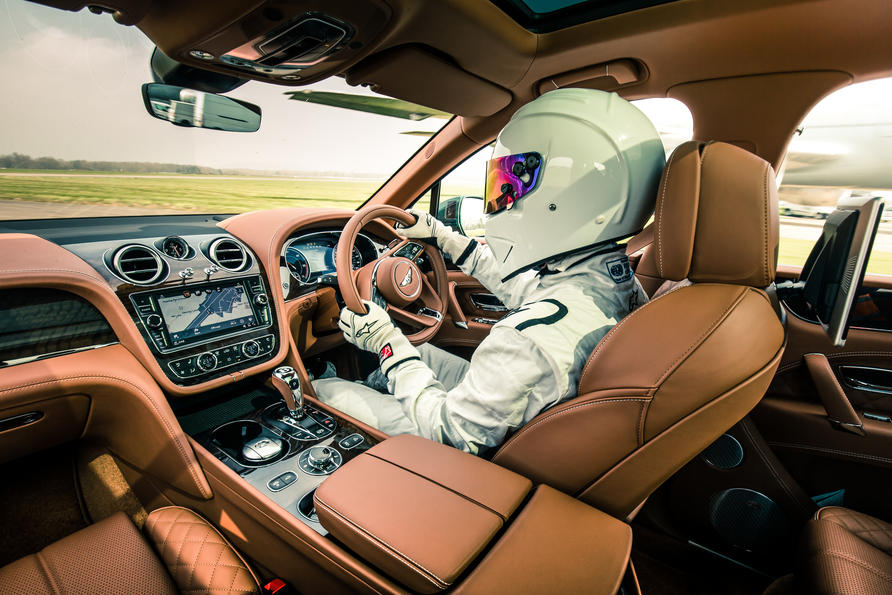
Audi SQ7: 10
Peugeot 3008: 9
Bentley Bentayga: 8
Land Rover Discovery: 7
Skoda Kodiaq: 6
Alfa Romeo Stelvio: 5
Jaguar F-Pace: 4
Dacia Duster: 3
Test Four: Desirability
Of course folks midway through their early evening shopping were drawn to the Bentley. You’d double-take if you found a gold bar in your sock drawer too. But showcasing our contenders In Leicester did reveal some interesting trends. After bee-lining for the Bentley Bentayga, at least five folks admitted that in the real world they’d genuinely be considering a Kodiaq. Every single person who wandered around the Discovery mistook it for a Range Rover at first. Women tended to prefer the Alfa, and men were more taken with the Audi and Jag. Despite its wilfully edgy styling and 22nd-century cabin, not a soul gave the Peugeot more than a derisory shrug at the badge. And the car that most Midlanders recognised without being prompted? The Dacia, funnily enough.
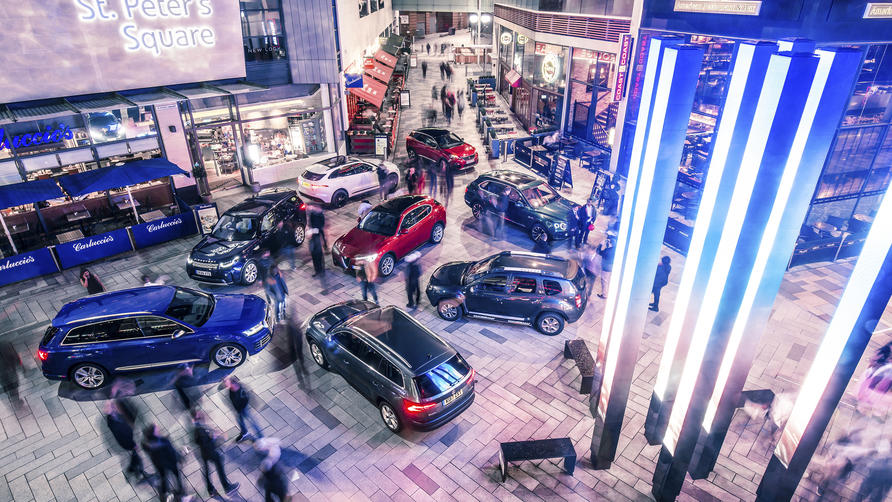
Bentley Bentayga: 10
Skoda Kodiaq: 9
Alfa Romeo Stelvio: 8
Land Rover Discovery: 7
Audi SQ7: 6
Jaguar F-Pace: 5
Dacia Duster: 4
Peugeot 3008: 3
Test Five: Sound
A decibel detector, a stretch of runway. Cruise control at 70mph, 6Music muted. Bentley making the quietest SUV is no surprise, but the Jag, on 22s and outshining the Audi, is, and who’d have thought a £25k Skoda is quieter than a £75k LR?
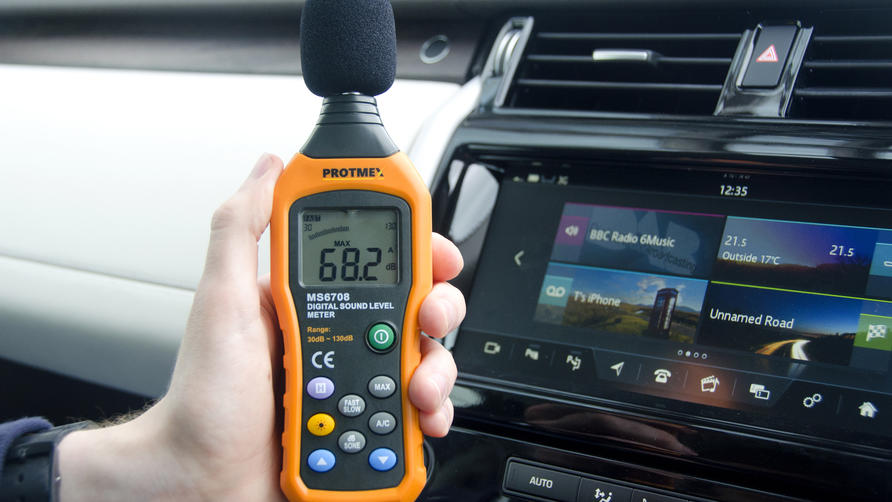
Bentley Bentayga: 10
Jaguar F-Pace: 9
Audi SQ7: 8
Skoda Kodiaq: 7
Land Rover Discovery: 6
Alfa Romeo Stelvio: 5
Peugeot 3008: 4
Dacia Duster: 3
Test Six: Cost
Sure, incinerating tyres and bog-wading are more fun, but it’s back to reality folks – costs are equally, if not more, important. Boo. We calculated the three-year running costs for each competitior assuming 10,000 miles a year and taking into account depreciation, fuel and road tax.
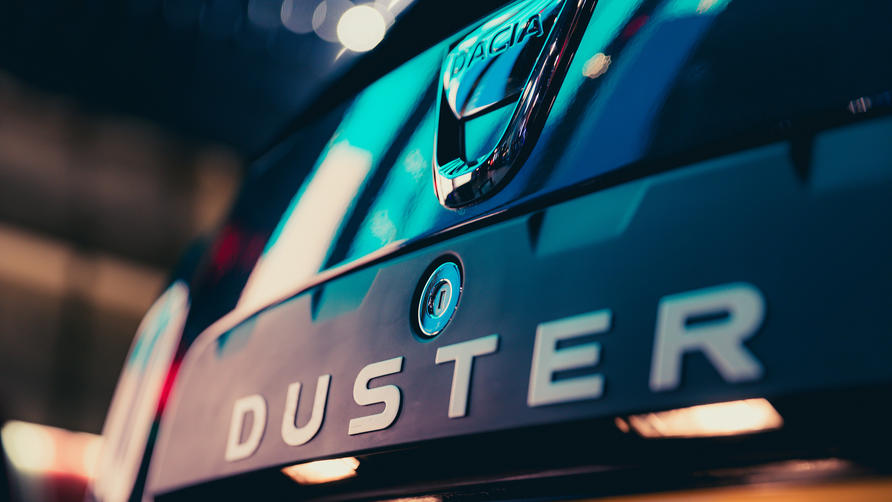
Dacia Duster: 10 £11,513
Peugeot 3008: 9 £14,933
Skoda Kodiaq: 8 £17,073
Alfa Romeo Stelvio: 7 £20,960
Jaguar F-Pace: 6 £26,080
Land Rover Discovery: 5 £29,534
Audi SQ7: 4 £31,291
Bentley Bentayga: 3 £61,273
Test Seven: Off-Road
So, you’re absolutely right. Hardly anyone who buys a Jaguar F-Pace, let alone one that tiptoes around on 22in wheels (twenty-twos!) will subject it to trial by quarry. We’ve done it now, so they won’t have to. And predictably, the Jag was outclassed in the rough. The ride, which it struggles to reconcile with British roads anyway, bounced occupants clean out of the seat, and, like the Alfa, its rear-drive-until-you-slip set-up isn’t really optimised for bushwhacking. Fearful of splintering the low-profile bumper and tyres on underwater obstacles, or a sharp-edged twig, these unashamedly road-biased SUVs were subjected to the least harsh off-road treatment. These are jacked-up sports saloons, with only a hill-descent mode between them as a sop to their go-anywhere marketing potential.
The Peugeot and Skoda are both FWD. You can spec 4x4 on a Kodiaq, but this version, with 148bhp and DSG ’box will be the top seller. It’s got greater approach and departure angles than the 3008, so it was happier off-road, but in fairness, once the Pug actually got some traction, its relative lack of mass and manual ’box helped it haul itself up steeper slopes than the Jag, Alfa and Skoda. Maybe a micron of Dakar rally DNA crept into its make-up…
Nah. If it’s underdog off-road status you’re after, look no further than the Duster. This is a brilliantly thought-out little workhorse. You don’t feel guilty hopping in and out of it, tramping mud into its thin carpet and smearing skidmarks onto the sills. It’ll rinse off. The rough steering-wheel hide and hard-wearing seat feel utterly appropriate for the abuse. And so’s the mechanical make-up.
Instead of fitting a low-range gearbox or hill-descent ESP mode, which would have added weight and complication respectively, not to mention cost, the Dacia simply has a very short first gear. Like a hillclimb car, I suppose. The ultra-short first can be used to haul it up an improbable slope or calm its descent down the other side. Its four-wheel-drive gubbins are brutally ordinary, but because it’s never having to apportion torque and take thinking time, it doesn’t fritter away traction. The steering, so slow on the road it’s a pain to park, doesn’t wrestle away and buck in your hands. I genuinely hope Land Rover is keeping one of these things close by when it cracks on with setting up its Defender replacement. As a no-bull, simple and sorted off-road car, the little Duster is a gem, so long as you’re willing to get involved. Get your hands dirty, rather than washing them of the experience.
Although the Audi and Bentley share their oily bits, interestingly, it’s the Bentayga that’s happier to remind you it’s a mud-plugger inside. Where the Audi hides its solitary off-road setting deep within the bowels of the drive select menu, the Bentayga’s mode dial (that elegantly encircles the starter button) has symbols for ice and snow, mud ruts, a desert and beyond. Mud ruts duly selected, with the body imperceptibly gaining altitude and the drivetrain optimised, it romped around off-road with more decorum than the Audi, which would get to the same angles if allowed more of a run-up and a dollop less mechanical sympathy. It’s worth mentioning all the cars wore their standard tyres – tyres that had all been subject to a thorough Stigging 24 hours earlier. Amazing, really, that on tyres that’ll carry its 2.5-tonne form north of 155mph, the Bentayga will happily blat around a filthy mudbath, transmitting so few ricochets and grumbles into its placid, serene cabin that you’re overcome with a slightly dangerous sense of invincibility.
Seems weird to subject a Bentley to this sort of treatment. And odder still to feel guilty about sullying a Land Rover’s paintwork. The rounded, professional-looking, slightly hoi-polloi Discovery has acquired a whiff of Chelsea tractor this time out. A tad too much Rangie in the styling, and with it, a sense it’s become inauthentic. Dispel those notions now. It is mighty off-road, whether you leave Terrain Response to its own, uncannily clever devices, or choose your preferred mode. Time and again I’d drive it into position for a shot, and see the rest of the TG team wincing and cringing at the angles it’s assumed. Inside, all was well. No sense of impending slip or toppling, just assured, calm, imperious progress. You can even try sabotaging the car, setting the toggle to prepare for snow and ice when you’re really in a muddy silt hole. Nothing upsets or intimidates it. For all the new image soul-searching, the Land Rover is still very, very much the real deal. The best 4x4 here by far.
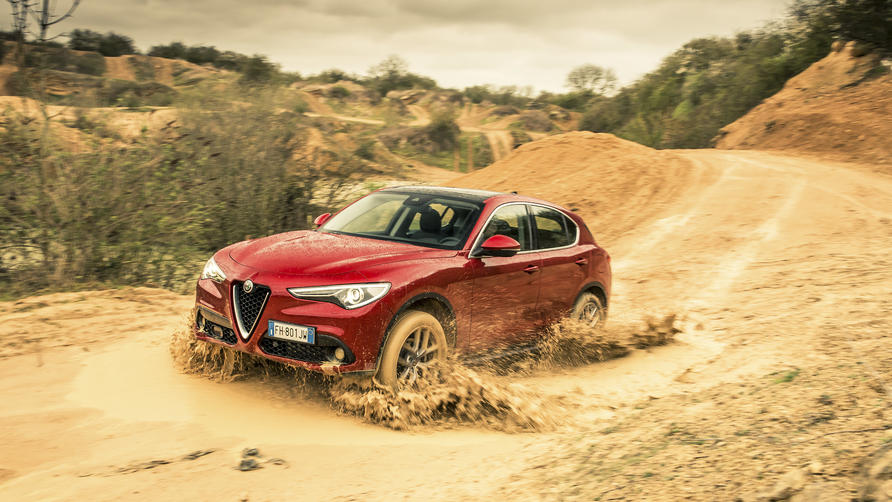
Land Rover Discovery: 10
Bentley Bentayga: 9
Dacia Duster: 8
Audi SQ7: 7
Skoda Kodiaq: 6
Alfa Romeo Stelvio: 5
Peugeot 3008: 4
Jaguar F-Pace: 3
Or… you could have the Kahn Flying Huntsman 6x6
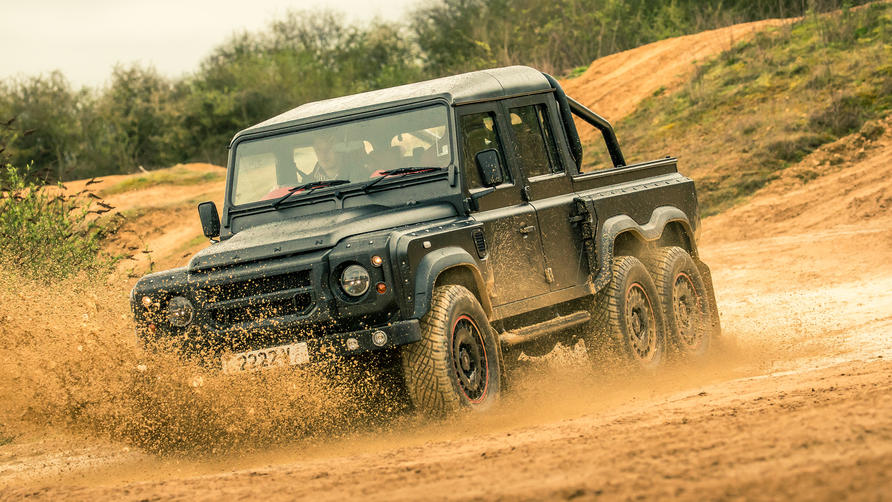
Yes, that’s a wide-body, six-wheel-drive Land Rover Defender pickup with quilted bucket seats, coming atcha outta Bradford priced at £129,545. And that’s for the six-wheel conversion. Throw in the bills for a donor Defender (out of production now, don’t forget) and associated upgrades and it’s £179,994, which makes the Bentley look like a bargain. Note the Kahn musters 122bhp.
It’s a long way from being the ultimate off-road toy, this. The rear axles have only a mite of articulation and the ride is so firm, you’re only supposed to engage 6x6 mode “away from hard surfaces, when traction is likely to be lost, and speed has to be kept below 40mph”.
So a proper Defender will leave it for spares in the rough. The jiggling steering wheel will damn near shear your fingers clean off too. Still, it’s half the price of a Mercedes G63 6x6, and will return equal Instagram hits in SW1. Which, you suspect, is the real purpose at work here.
Test Eight: Practicality
How do you measure a car’s practicality? Bootspace is an obvious metric, but rather one-dimensional. It’s how the packaging uses that space, and how accessible it is to the owner, that really matters. Nobody knows this more than an under-slept, over-stressed family man in a hurry. An ability to flip flop seats into the perfect load/people-carrying configuration
and appropriately install/remove a child’s car seat, all in world-record time and one-handed because you have a screaming child in the other, is crucial.
So there’s our test right there. The rear seats will begin folded flat, doors closed. Against the clock and while gently cradling a Stiglet in one arm, it’s my job to raise them to their correct position and strap in a child’s seat.
Beside my impressive display of athleticism, notable performances include the show-off Discovery, for which you can raise all seven seats via a phone app, switches in the boot
or a button on the central screen. The Stelvio, F-Pace and Bentayga all excel through the simplicity of just flipping the seats up with your spare hand, while the Peugeot and Duster let themselves down by trapping the seatbelt when you do the same. Dead last is the SQ7, which forces you to open the boot to raise the third row and run from one side to the other to release each half of the second row.
Luckily for the Audi, it covers its losses with a well-earned bonus point for being the most dog-friendly SUV in the world. How do we know this? When faced with eight open boots, a Bonio in each, Oakley the black Lab leapt into the Audi first. Now that’s science.
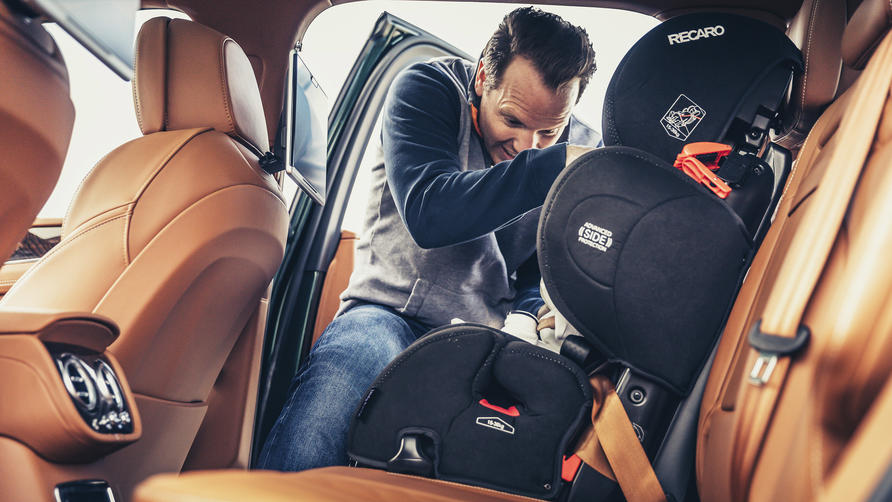
Jaguar F-Pace: 10
Alfa Romeo Stelvio: 9
Dacia Duster: 8
Bentley Bentayga: 7
Land Rover Discovery: 6
Skoda Kodiaq: 5
Peugeot 3008: 4
Audi SQ7: 3 + 1
The winner: Bentley Bentayga
The numbers have spoken, we have a winner... and, if we’re honest, it’s a shock result. Not least because it’s a car only a microscopic percentage of the population will actually
be able to afford. Costs were taken into account, of course, but given that for one Bentayga diesel you can have two Audi SQ7s, two-and-a-half Jaguar F-Paces, four Alfa Romeo Stelvios, two Land Rover Discoverys, five Peugeot 3008s, five Skoda Kodiaqs or nine Dacia Dusters, they probably should have had more weighting.
You see, that’s the problem with a verdict that takes opinion largely out of it – it throws up… unusual results. Perhaps the spread of tests unfairly favoured the fast and expensive stuff, perhaps we shouldn’t be let loose with a calculator, either way when you look at what we’d choose to take home below, it’s probably the wrong result. But in typically stubborn TG fashion, we’re sticking with it.
The key to the Bentley’s success? It performed well in categories we didn’t expect. Its looks are challenging at best, yet the fair folk of Leicester told us by a landslide that it was the one they would take home. And then, to our astonishment, when the going got muddy it kicked off its Gucci loafers and got stuck in.
The reality is that the Kodiaq and Disco both remain better family SUVs than the Bentayga, and the Alfa handles better, the Duster is remarkable for the money and the F-Pace is as rounded as ever. In fact, all our contenders were class leaders at the start of the test
and they still are, but it’s the Bentley that takes the points victory.
In hindsight, our points system probably needs an MoT.
Trending this week
- Car Review
Renault Clio




